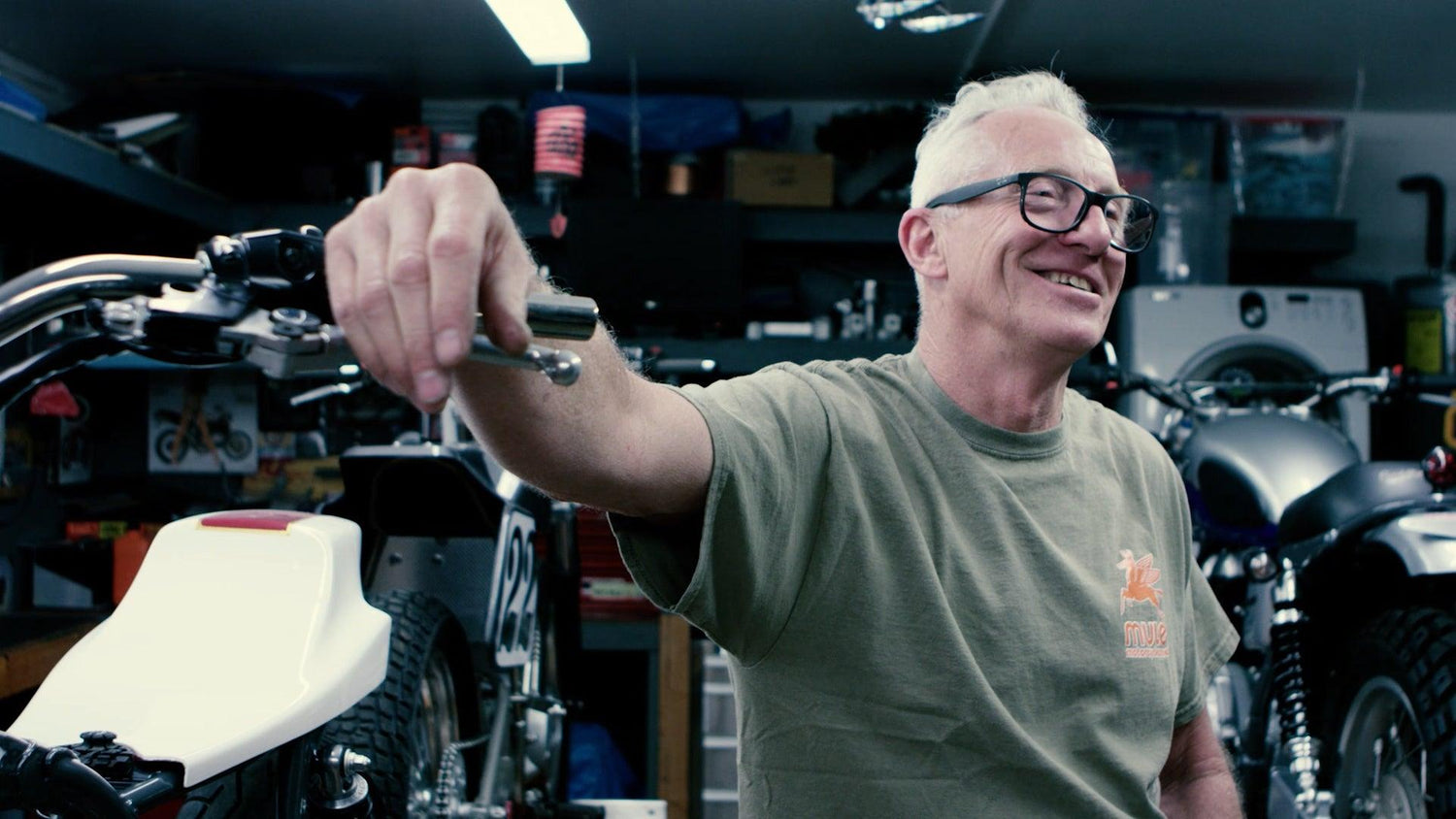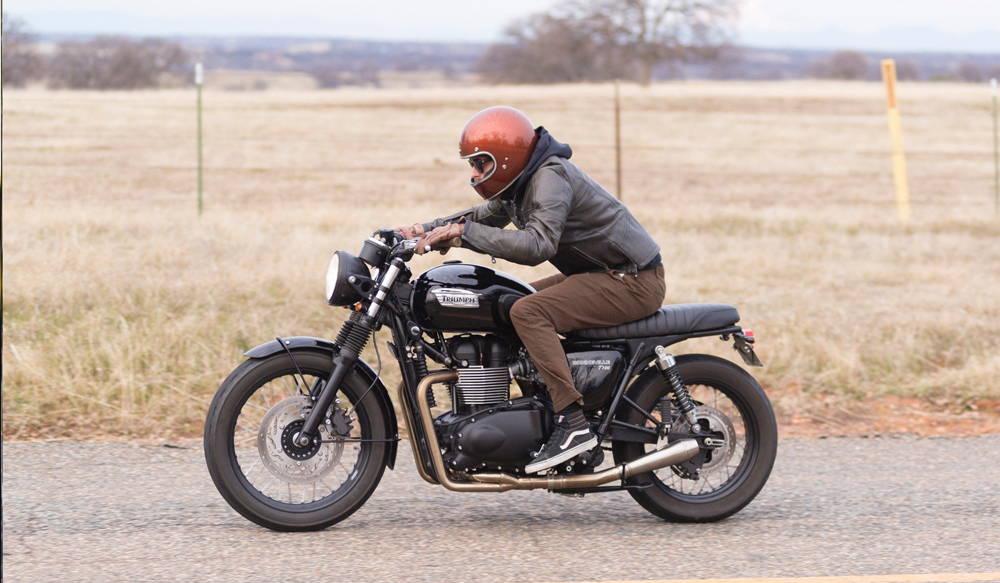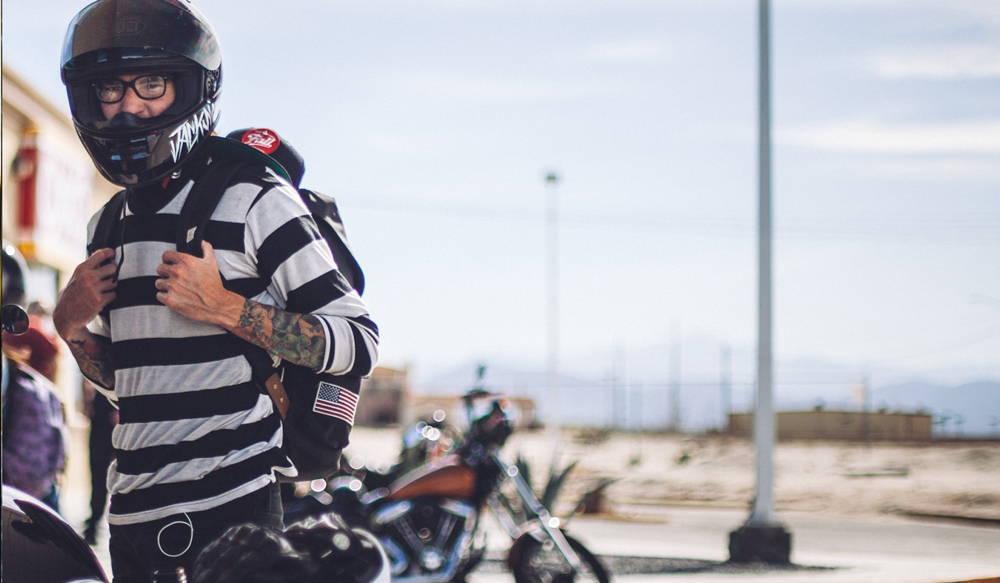Richard Pollock is the founder of legendary Mule Motorcycles. He's recognized as the godfather of the street tracker style of motorcycle, has had his custom builds on the the cover of Cycle World numerous times, is a pro level flat tracker, and is often considered one of the best custom motorcycle builders in the world. But he wasn't always all of these things. In the interview, he discusses the unlikely way in which he discovered motorcycles, the way his father inspired him to learn to work with his hands, how he worked his way up to becoming one of the finest custom motorcycle builders in the world, and more.
British Customs: How did Mule Motorcycles get started?
Richard Pollock: I got my first bike when I was 16, and I've been modifying bikes ever since. It's in my DNA. At 22, I started working in motorcycle shops and have always wanted to see and work on the latest stuff and modify my own bikes to take them to the next level. I did that for a long time. Later though, I got into the aerospace industry and became more confident doing more complex work like modifying frames, bodywork, and suspension components. Eventually, a friend of mine came to me in 1994 and asked me to do some modifications on his brand new Sportster. We did quite a lot to it, and it got a lot of publicity. And then people started calling and asking me to build them custom bikes. Over time, more and more people kept coming my way, and I just kept up with it and still do it to this day.
BC: What was your upbringing like? Who influenced you most growing up?
RP: My dad mostly, I think. He was an electrical engineer in the early days of the space program, as in literally from the beginning. He always fixed his own cars and appliances. He even built our first television. When I was growing up, he had a special record player he built that could cut the grooves into a vinyl record so he could make albums of my sister singing. He went to Yale and MIT and was in the space program during the Cold War, so I didn't know much about what his work involved, but he was a hands-on guy for sure. I picked up on that. Growing up in the 50s and 60s, hot rods and motorcycles were my main interest. Motorcycles were especially appealing because you could see everything and their workings, which made them even more fascinating to me. That really got me enthused in mechanical stuff, and I started working on bicycles and wooden downhill racers. That's how it started.
In my early years I grew up in Syracuse, New York, and then we moved to Daytona, Florida because my dad got a job at Cape Canaveral. At that time, you could get a permit at 14 years old to drive a motorcycle with up to 5 horsepower. So when I went to junior high in the early 60s in Daytona, there were probably 50 motorcycles in the parking lot. It isn't like now where you're lucky if you see one or two bikes in a high school parking lot and zero at a junior high. Bikes were huge; it was freedom for young people. All the kids would go out at lunch and look at all the bikes and talk about them and say, "Man, wouldn't it be nice to have a Triumph or a BSA?" And we would all just dream and drool. That was at a point where the nicest people were meeting each other on little Hondas. At that age, Triumphs weren't things you could have, which made you want one even more.
My parents weren't wild about motorcycles, but I remember being 15 and really wanting a mini bike — I thought that was the way to get my foot in the door. For Christmas I got a Vespa scooter. The next year, I got a Honda 305 Scrambler. My dad started riding the scooter and we couldn't get him off of it. Before I had the scooter though, my sister — who is older than me — came back from college ON A MOTORCYCLE and told my parents she had quit school. Shit hit the fan, though more about her quitting school than the motorcycle, but I was 15 and just thought, "Oh my god, having a motorcycle in the garage is great." My sister and I are three years apart, and she was really cool and really smart and hung out with the older kids. The bike she came home from school on was a Suzuki X6 Hustler, which was a pretty trick little bike at the time. She somehow got linked up with these guys at a motorcycle shop near Louisiana State University who were going to bike week (before it was called Bike Week), at Daytona, and so they gave her and her bike a ride. Later, she ended up going back to school and getting into computer science though. But man, I thought I was rebellious, but she was really rebellious.

BC: You have a background as an aerospace technician and have worked on numerous projects that have required extremely high levels of expertise and skill. How has being an aerospace technician influenced the way you go about designing parts and building custom motorcycles?
RP: I got to work on a number of first run designs where I had to figure out how to do the build, help design tooling, and come up with fixes if something didn’t work as planned. When I work on a bike and build something from nothing, I have to figure out the materials, the sizes, the dimensions, maybe build a prototype, test it, and then perhaps have to redo it. There are very few instances where I long to be an engineer or to have their kind of background and education to do what I do. But from time to time I wish I had “the paper.” I think I get by pretty well just from learning by doing and from the education I've gotten from working on things.
BC: When you’re designing a part, how do you balance form and function?
RP: It’s not really a conscious effort to balance it. I think there are physical laws in the universe: there are few straight lines, and lots of curves. Organic shapes with curves tend to be the strongest, can be made the lightest, and can be made to work the best. And when you see it, you say "Hey, that really has a nice look to it." When things function correctly and are well laid out, the form just comes, almost like a byproduct of everything being right. Meaning that form follows function. And if everything is designed correctly, and it's strong, and the angles are right, and the function is right, it's almost always gonna look bitchin'. Look at a Formula One car. The development over the decades wasn’t to make them look cool — that look (form), isn't where they started — but they wanted them to have a certain function (aerodynamics, lightweight, strength, power delivery, fat tires for traction), and now they look like racing birds with beautiful shapes. You look at a MotoGP bike that's been designed through-and-through to go around a track as fast as possible, and they're about the best looking bikes on the planet.
If you've ever seen an Indy car from 1910-1930 (or all Indy cars for that matter), you know they're beautiful. They look really good. Harry Miller was the guy who designed these works of art in the early days, and a Miller race car was a huge deal back in the day. His work was cutting edge because it was before a lot of the metallurgy and high-end engine design had been fully worked out. He had hundreds of patents for stuff he dreamed up. One of his rules in the shop was to make everything as light as possible. Another rule was that everything they were doing had to work awesome, and it had to look good doing it. His idea of making parts that work well, but that look good doing it, is something that I always think about whenever I'm designing something. I pull a lot of ideas from old cars, wooden boats, planes, and appliances. I also have a lot of Japanese motorcycle magazines which are interesting to me because they do everything so differently, they take such a different approach.
The problem I see in the custom motorcycle world is directly related to this issue. There are a number of guys out there making their first or second build, and they don't have a background in what makes a motorcycle work or function or handle well, but they've seen a lot of fads and trends online that they like, and so they come up with a bike that has a lot of styling cues, and like-minded individuals rave about them all over the internet, and all of a sudden you have a wave of modifications that don't make sense. You have to be very careful about taking chunks from one style of bike and throwing it on another because they may not always work together to improve the bike. You want it to function. That's the point. Bikes are so good now, de-evolving them for a fad seems out of touch. Sure, you don’t need 200 horsepower, but good handling and low weight and awesome brakes are always good on a bike.
When someone asks me about mods that they want to make to their bike, I look at it and think about how it will affect the bike. I ask myself, "Will it make it better, or just different?" A lot of guys don't realize that what they want to do on their bike is just part of a fad or trend. I try to push people towards improving their bikes instead of just changing the way it looks, although looking good is important to me as well and is for sure a part of the build.

BC: How did you get into flat tracking?
RP: It was kind of funny. The first shop I ever worked at was a shop in Florida called Honda Bob's, and the guy who owned the shop (Bob), had a Honda XL250 in a Redline frame, which was a flat track racing frame. He sent the motor to Yoshimura in California, and when he got it back it was a super strong runner. Once he set the bike up for short track racing, he invited me out, and I got to test ride the bike, and all the racers there had nickel-plated frames and fancy leathers and I thought it was a blast. Later, I attended the American Motorcycle Institute in Daytona and when I was finished there, I moved to San Diego to work. I was making $3.50 an hour for a while, and I still had to feed myself and pay for my apartment, so I didn't have money for racing for quite a while. In 1996 they built a track 10 miles from my house in Ramona, and I decided to get a bike so I could start racing there. So I bought a cheap bike, set it up, and started racing. The competitive community was funny because they weren't big on sharing information: they didn't want to help the competition. I, on the other hand, was always talking it up with everyone I could in the pits, drawing diagrams in the dirt and trying to help guys learn as I learned, because I thought it would make the racing better. It took some time, and there was a lot of trial and error, and I worked hard at it. After a while, I started winning races. Eventually, I started winning the pro class, and it was a circle of growth. I loved it, and I still love it.
When I was young, I was into surfing. Not everyone surfed at the time, and so surfing was really a way to spend a lot of time. You knew everybody, and everyone was friends. Then all the general public got into surfing and it got commercialized, and it started to become a hassle. As a kid, I couldn't imagine going a day without surfing. When I started flat tracking in the 70s, it was the NASCAR of motorcycles. Over time, flat track kind of faded away, so when I got back into it, not very many guys were still doing it. It was just like the sport was beginning again and it was a great time. And that's how I always looked at flat track. And I like that it's not mainstream; it kind of has a cult following. It's something that’s fun that you should try out. The biggest attraction to me for short track is that you have an average lap time of 15 seconds, and you're just going around in a circle, but another guy going around the same circle can do it in 14 seconds. It's so technical. It's still fun when you suck, but there are a lot of things you can learn to shave off a tenth of a second, and something else to learn how to shave another tenth of a second, and so on. I was at Del Mar one time in the qualifiers for a short track National event. There were 100 or so riders competing in the qualifiers, and only 48 make the program. I came in 49th. Jared Mees had the best time, but do you know how big the difference was between his lap time and mine? Four tenths of a second. That was some tight racing.

BC: What kind of platform do you prefer to work with when making a custom build? Air-cooled or liquid-cooled, and carbureted or EFI?
RP: I gravitate towards a bike that I can make big improvements on, whether it's improving handling or increasing power or reducing weight, and all for a modest amount of money. At the same time, having done stuff that's a total hassle, I also gravitate towards simplicity. On the internet, you see a lot of builds where they just took everything off and there isn't anything put back on and that's their version of simplicity. But I don't think that's custom. I like to have everything on there and working well while having reduced the overall complexity of the bike. Making something simple is very difficult. The simplest answers are always the hardest to get to. If I look at a motorcycle that someone else has built, oddly enough, the thing that I look most closely at is the bracketry and the way the components are mounted. Anyone can take everything off and cut the tabs, but the guys who can make new ones and relocate everything to get the coolest, cleanest setup are the guys that impress me the most. Simplicity also comes from carburetors and air-cooled platforms. They don't have a lot of digital crap. You want it simple. When I build a Triumph, I try to stay away from fuel injection models because they have something like 20 relays and sensors and a huge fuel pump in the tank that I have to deal with. For me, the golden years are the Triumphs made between 2001 and 2007. There are a million of those bikes out there that you can buy cheap and with low miles, and there are so many cool parts you can put on them. They're perfect for a builder.
BC: Not all your custom builds are Triumphs, but many of them are, and almost all of the parts you sell are for Triumphs. Why do you prefer to use Triumphs when building custom motorcycles?
RP: The primordial ooze of customizing motorcycles is the desire to make something better. So if Joe Average goes out and buys a Ducati Panigale R for $35,000, what can he do to it? Buy some titanium hardware or carbon fiber bits? He'll scratch his head and wonder what he can do to make it better, but the answer is he'll probably spend a ton of money for micro improvements. In the 40s and 50s, motorcycles were for transportation. In this day and age, it's about the passion, the freedom, the coolness. Motorcycles are 95% emotional. With that said, when you go to modify your bike, you want to feel good about doing it. If you buy a bike like the Panigale, they're really, really nice and they're powerful and they handle great, but nothing you can do is really going to make it better. That's where the Triumphs come in. Triumphs are manufactured as a kind of a basic bike. They're built to a lower price point. They're great if you want a bike you can improve or feel good about working on. In my little world of building street trackers, Triumphs are a good bike because they come in at a good price point, they're a lot lighter and cheaper than Sportsters and will make almost as much power, and most importantly, everything you throw at them makes them better, lighter, faster, and handle better. They absorb every modification you can throw at them. So when you throw on a pair of shocks or bars or triple clamps on it, or an exhaust system that makes the power skyrocket, all that makes it really fun and rewarding and that makes you happy as hell. And when you take it somewhere, you get to show off how it looks. I don't give the Ducatis a second look because the guy bought it, they didn't build it themselves.
BC: Where do you think the custom motorcycle scene is going? And where would you like to see it go?
RP: There was a time when bikes had decent power but didn't handle well. You had to be able to ride, but also be able to work on the bike and make it handle better. There was a time when I raced around in the mountains on an RD350 against guys on CB550s and Sabers and GPZs. All week I would work on my bike trying to make it better so I could beat the other guys, and then on Sunday I would go out and do battle. And they were all doing the exact same thing. We were motorcycle hot rodders who modified our motorcycles because we wanted them to be better at what they were meant to do. I think that's what's missing from the custom scene. Now you can go in with a credit card and buy a stock bike that’s ten times better than you are.
Don't misunderstand, though. I think there are two kinds of builders: the guys who want to build a custom bike that looks cool, and the guy who wants to build a highly functional bike. And there's nothing wrong with either.
BC: What would you suggest to someone thinking about building their own first custom motorcycle? Where should they begin?
RP: The first thing somebody needs to do is ride. After you start riding, you start dabbling with the idea of working on it, and then you finally put a wrench to it, and you make mistakes and learn as you go. Once you have a foundation to build off of, you don't jump in on a custom bike and start building frames; you have to learn how to walk before you can run. Now, if a guy is a really skilled welder or worked in fabrication, he could probably build his own tank or seat and dive right into making custom parts. Joe Average, though, would have to start out by buying accessories and learning by installing them on the bike. Little things like replacing the grips or troubleshooting why your throttle is stuck and replacing the cables to get it to work properly. You have to work your way up, and can't be afraid of that. I started out just riding and breaking bikes, which naturally lead to working on them. After fixing them came attempting to make them better, then building them from scratch. The more you do, the better you get and most importantly, learn who to listen to. Listen to criticism. A fresh set of eyes is critical to learning. You’ve got the rest of your life, be patient and do things right. Your bike will come out a lot better.







Leave a comment
All comments are moderated before being published.
This site is protected by hCaptcha and the hCaptcha Privacy Policy and Terms of Service apply.